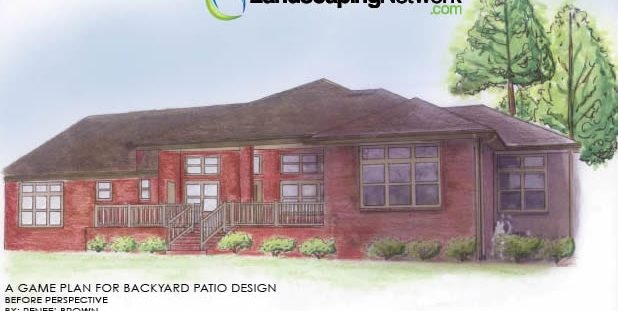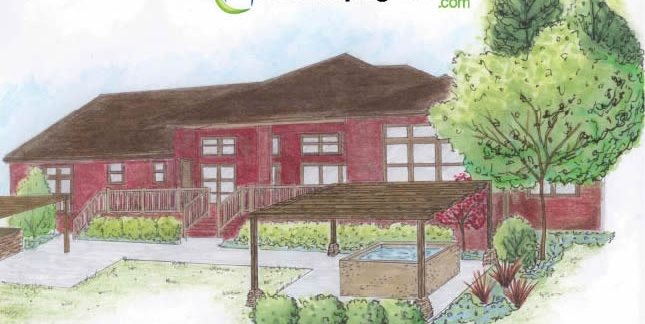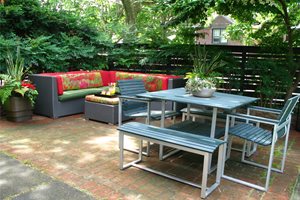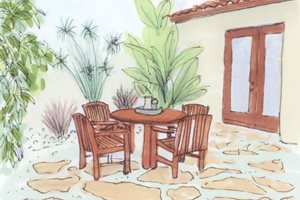Backyard Patio Design
An explanation of the design decisions made for a residential backyard patioThe floor plan of this large family home with its doorway access to the patio drives the entire circulation plan, but once free of the building the outdoor living spaces take on a life of their own. The developer provided an elevated patio for this raised foundation brick home with its oversized view windows. A single staircase connects the elevated space to the ground level backyard.
For this and all other patios, design is a synthesis of all the above criteria. It is viewed as problem solving.
- Problem: The house is a given with all solutions being specific to the opportunities and constraints it presents.
- Problem: Its finish floor elevation is four feet above grade making the home feeling overly massive when viewed from future ground level outdoor living spaces.
- Problem: Parents want a quiet spa space separate from outdoor cooking and dining spaces.
- Problem: Outdoor living areas need shade and protection for use during inclement weather.
Design Criteria
This design layout includes the owner's specific requests. They asked for a spa for the parents to get away from the kids in the evening, a large outdoor dining and entertaining area where everyone can congregate with a built in barbeque cook center. There must be shade for hot afternoons and to make the spa more intimate. To cut costs and allow higher end materials they asked for only enough paving to get the job done.This plan is laid out into two primary use spaces. On the north end is passive space adjacent to the master bedroom. The active outdoor entertaining area is on the south end where it is better linked to the bathroom, kitchen and family room. In between these the paving is minimized to allow turf grass, however, it is possible in the future to add more paving in a future phase should there be a need for more square footage on this very large lot.
Design Decisions
All things begin with connections, and with this home it pivots on the large staircase that descends three feet down to finish grade. This becomes a quasi symmetrical hub which draws the eye outward into the very large backyard. But this can become a bottleneck too, possibly inconvenient for entertaining and outdoor dining.The first design decision is to install a second narrower staircase on the north end of the elevated patio. This will provide another way to reach ground level without crowding. It's also more convenient for traffic between the kitchen and outdoor dining areas. Such an addition also provides a direct access to a bathroom from outdoors. This is a big help when kids are muddy or for guests using the spa so they need not track water across the patio.
Because the finish floor of the house is elevated so high above the ground, it's vital to create generous foundation planting areas that more gracefully transition the upper patio to grade. This width allows for tiered planting that gives the home a more nested appearance. Planting cloaks vents, utilities and visible foundations with more attractive foliage and flowers.
- Pro Tip: In planning patios, anytime they are flushed up against the walls of the home, the ability to create sizable planting areas is lost altogether. But when you plan for them with generous five and eight foot deep planting zones, there is room to use a wide range of trees and shrubs.
The purpose of two different depths is too to foil the long north-south face of this home. Anytime irregular lines are used, there will be additional interest. The final product will stand out distinctly from simple, cookie cutter patios typical of tract homes.
The outdoor kitchen is located on the south end of the patio where it is intuitively accessed through both the back door and a guest bath. This ensures that the coming and going with food and supplies does not interfere with the main flow of family and guest traffic going down the main staircase. The outdoor kitchen or built in barbecue is close to the house yet well out of the view of most of the home windows. A cook center may go largely unused during the winter months and therefore should not be located where highly visible from indoors.
The outdoor dining space is well out from the house to catch summer breezes. The pergola with its open beam design offers a shade structure that does not interfere with air movement. Vines may be planted for additional shade and to soften the rigid nature of this large paved area. There is enough space left to the north of the pergola to allow dining al fresco, which is desirable in the morning or during those cooler days of spring and fall.
The north end of the patio is a passive space composed to meet the needs of the parents. The master bedroom opens onto the main elevated patio and users then descend the main staircase to reach the spa with its own pergola for both privacy and shade. This portion of the patio is designed to allow dense privacy planting on the north and east side to block views from neighboring two story homes. Vines may be added to this pergola, or a low maintenance removable canvas cover provides both overhead privacy and rain protection. The master bedroom picture window looks out toward the spa and the small open space designed for quiet seating. Even when there is a great deal of activity on the south end, this north portion retains its peaceful appeal.
Every design decision for this or any other patio must be a synthesis of many factors. It is often a process of solving specific problems, and in doing so the space evolves in an organic way. Your designer will massage the spaces, their juxtaposition and amenities until all needs and met, all problems are solved and the result is the perfect mix of beauty and usability.

 Backyards
Backyards
 Front Yards
Front Yards








